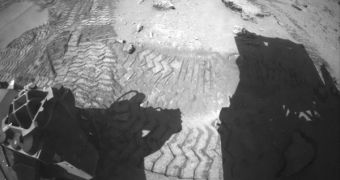Mission controllers at the NASA Jet Propulsion Laboratory (JPL) in Pasadena, California, announced yesterday, February 11, that the Mars Science Laboratory (MSL) rover Curiosity has finally moved forwards on the Red Planet, after spending several days plotting a safe course.
The rover's advance was halted over concerns that a patch of difficult terrain featuring sharp rocks would significantly affect its aluminum wheels. Some of the 6 wheels are already heavily dented and cracked, even though the robot has only traveled 4.97 kilometers (3.09 miles) since landing on Mars.
The mission's long-term goal is to reach the 5-kilometer (3.1-mile) Mount Sharp, an ejecta cone located at the very center of the massive Gale Crater where Curiosity landed. While on the way, JPL scientists constantly look for potential science targets such as meteorites or exposed outcrops.
In early February, rover drivers had to stop for a while and assess the best possible route forward. In front of the robot was a ridge with a single gap through which the machine could pass. A large dune over-arched the gap, and this is where Curiosity drove through on February 6.
On Sunday, February 9, Curiosity took another drive, this time covering a total of 41.1 meters (135 feet). JPL scientists say that the ground ahead is more easily navigable, and unlikely to damage the rover's wheels any further. The rover's immediate surroundings are monitored via the Hazard-Avoidance Camera instrument.
The rover is still a long distance away from Mount Sharp, but experts at NASA are convinced that the robot will eventually reach its primary target in one piece. It is fairly difficult to estimate exactly how long it will take until the rover starts climbing the cone's slopes.
Curiosity was built by Lockheed Martin and the Boeing Company for NASA, and is managed for the agency by JPL. It features a total mass of nearly a ton, and a size comparable to that of a Mini Cooper. The project took a total of $2.5 billion (€1.83 billion) to complete.
The rover was launched into space aboard an Atlas V delivery system on November 26, 2011, from Launch Complex 41 at the Cape Canaveral Air Force Station, in Florida. After spending roughly 10 months in space, it successfully landed on Mars on August 6, 2012.

 14 DAY TRIAL //
14 DAY TRIAL //